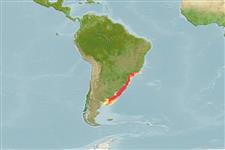Common names from other countries
Environment: milieu / climate zone / depth range / distribution range
Écologie
; profondeur 0 - 125 m (Ref. 109222), usually 0 - 68 m (Ref. 8). Subtropical; 8°C - 22°C (Ref. 8), preferred 15°C (Ref. 107945); 23°S - 43°S, 65°W - 41°W (Ref. 8)
Southwest Atlantic: East coast of South America from Rio de Janeiro, Brazil (23°S) to Puerto de Rawson, Argentina (43°S).
Length at first maturity / Taille / Poids / Âge
Maturity: Lm 2.8, range 1 - ? cm Max length : 10.6 cm TL mâle / non sexé; (Ref. 130); 15.2 cm TL (female)
Demersal-benthic (Ref. 114628). In sandy or muddy substrates (Ref. 109222).
Life cycle and mating behavior
Maturité | Reproduction | Frai | Œufs | Fécondité | Larves
Members of the order Decapoda are mostly gonochoric. Mating behavior: Precopulatory courtship ritual is common (through olfactory and tactile cues); usually indirect sperm transfer.
Boschi, E.E. 1969. (Ref. 130)
Statut dans la liste rouge de l'IUCN (Ref. 130435)
statut CITES (Ref. 108899)
Not Evaluated
Not Evaluated
Utilisations par l'homme
Pêcheries: intérêt commercial mineur
FAO - pêcheries: landings | FishSource | Sea Around Us
Outils
Sources Internet
Estimates based on models
Preferred temperature
(Ref.
115969): 10.5 - 22.5, mean 14.7 (based on 236 cells).
Résilience
Milieu, temps minimum de doublement de population : 1,4 à 4,4 années (K=0.08-0.69; tm=0.33).
Prior r = 0.52, 95% CL = 0.34 - 0.78, Based on 1 data-limited stock assessment.
Vulnérabilité
Low vulnerability (10 of 100).
